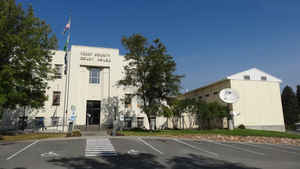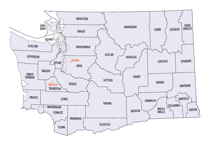Washington Counties
There are thity-nine counties in the state of Washington. Washington was carved out of the western part of Washington Territory and admitted to the Union as the 42nd state in 1889. The first counties were created from unorganized territory in 1845.Ferry County, Washington
Ferry County Education, Geography, and History

Ferry County is a county located in the state of Washington. Based on the 2010 census, the population was 7,551, making it the fourth-least populous county in Washington. The county seat and largest city is Republic. The county was created out of Stevens County on February 21, 1899 and is named for Elisha P. Ferry, the state's first governor.
Etymology - Origin of Ferry County Name
Elisha P. Ferry, the first governor of Washington.
Demographics:
County QuickFacts: CensusBureau Quick Facts
Ferry County History
Ferry County was created 18 February 1899 from Stevens County, is bounded by British Columbia on the north, Stevens County on the east, Lincoln County on the southwest, and Okanogan County on the west. Its county seat is Republic.
Ferry County
Like all areas of Washington Territory, Ferry County was explored by many famous explorers, such as David Thompson of the Northwest Fur Traders and David Douglas, the noted botanist.
One notable adventurer-explorer was Ranald MacDonald who panned the creeks flowing into the Kettle River and Boundary Creek in search of gold. Ranald was the son of Chief Trader Archibald McDonald and Princess Raven, daughter of Chief Concomly of the Chinook Tribe. He traveled all over the world,
and the Japanese revered him as their first teacher of English. Ranald died on the Colville reservation in 1894 in the arms of his niece, Jenny Lynch. She was the daughter of his half-brother Benjamin MacDonald and an Okanogan Indian, Catherine Michel. Cabin where Ranald died
In addition fur trapping, Ferry County area was used as a hunting and food-gathering area for the Interior Salish peoples, now commonly referred to as the San Poils, the Okanogans, the Colvilles and the Lakes. Okanogan Indians grazed their animals on the bunch grass along the Tonasket creek (now
Toroda) during the winter months.
Many tribes were scattered throughout Ferry County. The confluence of the Columbia and the San Poil River was the home of the San Poil. The Kettle River, both east and west of the Kettle Range, had a concentration of members of the Lake Tribe, and Inchelium on the western side of the Columbia was
the home of a band of Colvilles.
Because of other pressing matters, Territorial Governor Isaac Stevens postponed discussing territorial rights with tribes in Ferry County since the local Salish Tribes did not threaten the invasion routes of the settlers moving into the area or the territorial designs of the government, they were
essentially left out of negotiations until after the Civil War.
Although Chief Tonasket of the Okanogans attended the Indian conference at Grand Ronde and later at the Yakima Treat negotiations, the tribes of this area were not given reservation land until 1872 when the Colville Reservation was created by President Grant through a presidential executive order.
The reservation had as its boundaries the Okanogan River to the west, the International Border to the north, the Columbia River to the east and south. Chief Tonasket
The original Colville reservation was steadily reduced as a result of pressure from settlers and miners who had invaded the area, particularly in the Okanogan and Columbia River areas as well as the Colville River Valley. Others crossed the reservation on their way to the Cariboo and Rock Creek gold
fields in Canada, or they searched the local streams for gold. In the 1860's Chinese placer miners were in the Malo area and many areas of the reservation supported rudimentary homes for early trappers and hunters.
The reservation system broke down after Congress passed the Allotment Act of 1887. The Allotment Act was part of the Dawes Act which granted 80 acres of reservation land to each registered member of the tribes before the land was opened for white settlement. Many families who had a mixed-racial
heritage from the fur trade moved onto the Colville reservation and began ranching operations. Many of the creeks and roads were named after the children of fur-trade families: Herron, Peone, Gendron, Desautel, La Fleur, St. Peter and O'Brien to name just a few. Other early pioneers in the Okanogan
who had been mining in that area, such as Arthur Best and George Runnels, had Indian wives and moved onto the reservation where they developed their mining interests. Baptista
In 1884 Chief Tonasket, along with other members of his band, felt the pressure of white settlers in the Northern Okanogan and moved to the Toroda Creek and Kettle River area. They brought with them their cattle, sheep, horses and possessions. Martin Tonasket brought farm implements over Cummings
Pass, and Martin Alec brought over the first wagon to the Colville reservation, piece by piece on pack horses.
Chief Tonasket and his sons were one of the first Indian families to raise hay for their animals and develop ranching techniques. Grain was cut by cradling and then threshed by horses trampling on the grain in a specially constructed corral. The winnowed grain was packed on horses and sent to the
markets in Marcus and Spokane.
There was also a local economy on the reservation. Chief Tonasket, Chief Long Alec, and Dennis Peone owned the first stores on the northern-half of the reservation. Eneas and Louise Somday owned a boarding house and stage coach depot from 1896-1905 Chief Long Alec also operated a ferry across the
Kettle River in addition to his store. Chief Long Alec
Long Alec, Tonasket and the inter-related Somday family tried to help their people in their adjustment to agriculture and survival on their respective allotments. Both Tonasket and Somday were strong supporters of the establishment of schools. Long Alec, Tonasket and Somday were also enthusiastic
supporters of the efforts of Catholic priests in their Christianizing efforts on the reservation.
The northern half of the Colville Indian Reservation was opened to mining in 1896 and shortly later homesteading. The southern half of the reservation was open to mining in 1898 and homesteaders shortly thereafter. Today the Reservation Lands encompass 1.4 million acres with the headquarters of the
Colville Confederated Tribes at Nespelem.
Ferry County was created in 1899 and named for Governor Ferry, the last territorial governor and first governor of Washington State. The county seat, Republic, has had a mining history from the time of its inception. For many years in the 20th century, the Republic mines were the major producers of
gold in Washington; the last remaining operational gold mine in the state is in Republic.
This information was provided courtesy of Mary Warring, former President of the Ferry County Historical Society.
Economic
Ferry County covers 2,200 square miles of rugged, mountainous terrain in northeast Washington. The county is bound by Canada to the north, Stevens County to the east, Okanogan County to the west, and Lincoln County to the south. The City of Republic is the county seat, and the only incorporated city within county limits. The Colville Confederated Tribe owns the southern portion of the county, while the northern half makes up a portion of the Colville National Forest. Ferry County is considered "frontier" country. It has often been stated that the only ways in and out of the county are over the highest year-round mountain pass in Washington, aboard a ferry, or through a foreign country. The community is full of determined and resilient people, many of them the descendents of homesteaders who came to the area to find their fortunes in gold or timber . Ferry County is an area rich in history, and is considered a geological phenomenon with the internationaly renowned StoneRose Fossil site. Today, people come from all over to enjoy our four seasons of recreational opportunities.
Ferry County's prosperity was based on gold mining, timber, and agriculture. Today there is little mining, and timber and agriculture have declined from their former importance. Yet much of the scenic beauty of Ferry County remains undiminished, and tourism, hunting, and fishing help sustain the economy.
Geography: Land and Water
As reported by the Census Bureau, the county has a total area of 2,257 square miles (5,847 km2), of which, 2,204 square miles (5,708 km2) of it is land and 53 square miles (139 km2) of it (2.37%) is water.
Ferry County is 2,257 square miles in area. By the 2000 census, the population was 7,260, with a density of 3.3 per square mile, the lowest
of Washington counties. The Colville National Forest and the Colville Indian Reservation occupy large tracts of land within the county.
Historically,
Neighboring Counties
Bordering counties are as follows:
- Stevens County, Washington east
- Lincoln County, Washington southwest
- Okanogan County, Washington west
(also shares northern border with British Columbia, Canada)
- Kootenay Boundary Regional District, British Columbia
Education







